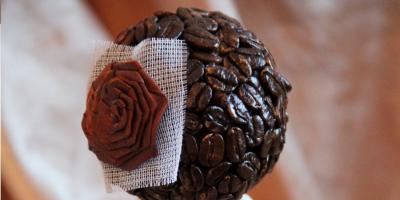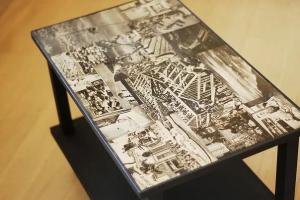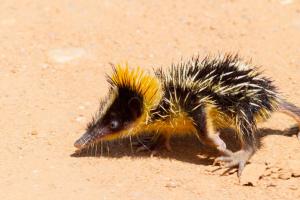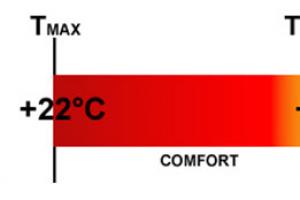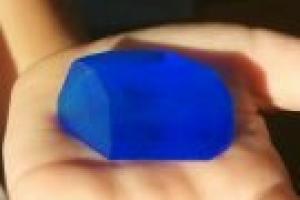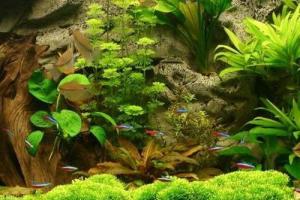- 43.8k
Guys, we put our soul into the site. Thank you for that
that you are discovering this beauty. Thanks for the inspiration and goosebumps.
Join us on Facebook And In contact with
Madagascar is sometimes called the land of lemurs. By the way, the first Europeans who came to the island found these animals with glowing eyes frightening. Observing their nocturnal lifestyle and slow movements, the scientist Carl Linnaeus remembered the legends of Ancient Rome about the souls of the dead who could not find peace and named the animals in their honor - lemurs. We want to tell you about what other mysterious things Madagascar is full of.
website I am convinced that this not fully explored island is a real treasure for miracle seekers. Spiders here weave golden webs from which fabric can be made, sorcerers control the destinies of people, and nature amazes with its contrast and diversity.
Fact #1: Madagascar broke away from India, not Africa
135 million years ago, the supercontinent Gondwana broke apart, separating a portion including India, Madagascar and Antarctica from South America and Africa. A about 88 million years ago Madagascar separated from India. Thanks to long-term isolation, a completely unique flora and fauna arose on this island.
Fact No. 2: Madagascar's culture has a bit of France and the Arab East
The settlement of the island lasted from about 200 BC. e. before 500 AD e. People arrived in Madagascar by kayaks from the Greater Sunda Islands, in particular from the island of Borneo. They cut down and burned large areas of rainforest to grow crops.
Between the 7th and 9th centuries, Arab traders appeared on the island. From them, part of the population adopted Islam, writing and other elements of culture. Some tribes, like Muslims, do not eat pork.
In the 10th–11th centuries, Bantu-speaking migrants from Africa and Indian traders arrived in Madagascar. . Exactly thanks to the latter, local cows (zebu) and rice appeared on the island.
Later, the Austronesians arrived on the island, European pirates took a fancy to it, and the French made it a colony. From the latter, the local population adopted a love for baguettes and vanilla.
Near 90% of all species of Madagascan plants and animals are found only on this island. Because of this, some ecologists call it the eighth continent. Some animals really look like creatures from another planet. Here you can find such strange animals as tenrecs, and such creepy creatures as the Madagascar bat, which uses its long middle finger to pick out insects from the tree and tidy up its fur.
Madagascar little arm (ouch).
Not only snakes hiss here, but also huge cockroaches. And a giant rat, up to 33 cm long, can jump 91 cm in height.
There is also golden spider, females of which reach 12 cm in leg span. The existence of this species was not known until 2000. Female golden weavers weave a web of golden threads more than 1 m long. This web is strong enough that it was even possible to weave 3 m of golden fabric from it, which is kept in the museum.
Fact #4: Instead of creams and masks, women paint their faces
Some Madagascan women paint colorful patterns on their faces with white and yellow paint. This paint is made from crushed tree bark and is applied not only for decorative purposes. Its purpose is protect skin from sun and insects, in particular mosquitoes. It is also believed that such paint improves the condition of the skin, that is, it serves as an analogue of a cream or face mask.
Fact #5: There are no hippos, lions or giraffes on the island
There are red owls, iguanas, boa constrictors, many species of chameleons and lemurs, and other unusual animals. But there are no penguins, lions, hippos, zebras or giraffes. You will also not see elephants, hyenas, antelopes, rhinoceroses, buffalos, monkeys or camels here.
The absence of these animals is explained in the same way as the presence of unique species: centuries-old isolation of the island. The only large mammals found on the island were hippos. Several species originated from them, but they also became extinct long ago.
Sifaka is one of the species of lemurs found in Madagascar.
Fact #6: Madagascans dance with the dead
Some Malagasy tribes (the main population of Madagascar) have an eerie tradition. Once every 5–7 years, they take their dead relatives out of their crypts, dress them in a new silk shroud, and dance with them to music. Famadihana tradition - "turning the bones"- is based on the belief that the spirits of the ancestors will join the world of the ancestors after the complete decomposition of the body and the appropriate ceremonies.
Relatives from all over the country come to perform the ceremony. During Famadihana, Malagasy people have fun and make offerings to the dead: alcohol or money.
Fact No. 7: All decisions are made only after the approval of the sorcerers
In choosing the day for marriage, the beginning of building a house and any other vital events Malagasy people turn to the sorcerer - umbiasi. It also helps determine whether the couple will be compatible and will help carry out the necessary ritual. Umbiasi are also healers; they know the properties of plants and tell them how to care for the sick.
For fortune telling, sorcerers use corn grains or fruit seeds. They also sell talismans made from dried vegetables, animal teeth or glass beads.
The landscapes of Madagascar are varied and they change at every turn. On the island you can wander through the jungle and see baobab trees with huge trunks. In some places, the laterite content gives the soil a red tint. For this reason Madagascar is also called the Great Red Island.
The Antemoro Muslim ethnic group, which is of Arab origin, has a caste system.. The Antemoro people still make handmade paper from the bark of mulberry trees. You can visit the Antemoro factory for free and even take part in the production of sheets yourself.
The amazing country of lemurs - Madagascar, amazes not only with its unique culture of local peoples, but also with its striking natural contrast. More than 90% of living creatures on the island live only here; they cannot be found on another continent.
1. Dancing with the Dead
Of course, the culture of the local population is also rich in its own special traditions that are foreign to us. Like, for example, dancing with deceased relatives. This ritual is called "tradition" Famadikhani"(turning over the bones of the dead). People here believe that the soul of their relatives will join the world of their ancestors only after complete decomposition and similar rituals. To perform this ceremony, the corpse is dressed in a silk shroud and danced with it - this procedure is repeated every 5 -7 years
2. Strange animals

The animals on the island are so exotic that you get a feeling of alienness. They live here giant cockroaches, which are capable of hissing like snakes. And rats can jump up to a meter in height.
Hedgehog in Madagascar cannot boast of its cute appearance - this yellow-orange “miracle” is a mixture of an opossum, a mole and a shrew.
Also on the island are spiders, which were discovered quite recently. Their golden web is very durable and suitable for weaving fabrics - one such 3-meter specimen is kept in the local museum.
3. A lake that cannot be crossed and a stone forest

There is a dead lake on the island of Madagascar Tritriva, in which you will not find a single living creature. It is also believed that this body of water cannot be crossed. In fact, this “sinister” ban is based on the fact that the lake contains a lot of sulfur, the vapors of which are very dangerous to inhale.

Another one of the wonders of the island is the stone forest, which is called " Tsingy du Bemaraha". This place has essentially not been explored at all, since visiting it requires special equipment, because almost the entire forest area is impassable for humans.
4. Twins born abandoned in the forest

The people of Madagascar, of course, like any other society, have their own traditions, taboos and superstitions. Some of which seem completely illogical and immoral. In the southern and eastern parts of the island there are tribes in which the birth of twins is considered witchcraft and misfortune. And in order not to cause trouble, the mother who gave birth to twins is forced to get rid of the offspring. Most often, babies are abandoned in the forest. If the mother does not agree to do this, she will simply be expelled from the village. Of course, at the moment, this practice is prohibited, but still many communities do not follow these prohibitions.
5. Natural exchange still works

If you ever travel to Madagascar, you will find that along the road the local population displays pots, honey and other goods. So, you can simply exchange the item you like for alcohol, tobacco or something else.
6. Love French baguettes and no pork

The history of settlement and development of life on the island of Madagascar is very interesting. From as early as 200-500 BC. People from the Sunda Islands sailed to the island to grow and harvest crops, and around the 7th-9th centuries, Arab traders appeared, thanks to whom the local population adopted culture, writing and religion. And since Islam prohibits the consumption of pork, many tribes still do not eat this type of meat.
7. Madagascar - the island of lemurs

The island's isolation means that large mammals do not live here. You will not see lions, zebras, or giraffes in Madagascar, as well as rhinoceroses, antelopes, monkeys, camels, etc. The only large animals found on the island are hippos, which eventually became extinct.
But lemurs and chameleons, snakes and iguanas live quite comfortably on this island.
8. Sorcerers decide everything

Any important issues in life are resolved by local sorcerers - umbiasi. If you are going to build a house, start a family, or make some significant decision, you need the sorcerer to perform the necessary ritual, and then act according to the instructions of the spirits.
9. Salary of 1 dollar

Yes, Madagascar is one of the poorest countries in the world and, on average, 1 day of work here is valued at around one dollar. Income levels are so low that most suffer from hunger. And buying a simple newspaper will be considered an unaffordable luxury.
10. Madagascar separated from India, not Africa

More than 130 million years ago, the continent of Gondwana split into parts, as a result of which Madagascar, along with Hindustan, moved away from Africa. And later Madagascar separated from India, and remained a separate small world with its own unique flora and fauna, located almost on the equator.
Below is a selection of interesting data and facts about Madagascar. You can also see beautiful photographs of this island.
Historical facts about Madagascar:
- Madagascar is an amazing island nation in the Indian Ocean, located off the southeast coast of Africa. Millions of years ago, the island was part of the single land of Gondwana, and about 60 million years ago it was the first to separate and become the first island on Earth.
- It is known that the first people arrived on the island only 2000 years ago.
- Interesting fact: for the first time Madagascar was noticed at the beginning of the 16th century by the Portuguese navigator Diego Diaz. Since then, the island has become one of the most important trade points on the way to India.
- In 1896, the entire island became a French colony, and already in 1946 it received the status of an overseas territory of France.
- The island state received complete freedom and independence in 1960 from.
- Did you know that Madagascar has been renamed twice? This first happened in 1975, when the official name Democratic Republic of Madagascar was adopted. And for the second time in 1993 they renamed it to the name “Republic of Madagascar” that is already familiar to us.
- In 1990, after almost 20 years of Marxist rule, Madagascar lifted the ban on opposition parties. And already in 1993, a new president was elected.
- The official languages are Malagasy, French and English.
- Madagascar is the fourth largest island in the world after Greenland, New Guinea and Borneo. Its coastline is 4828 km.
- Interesting fact: the island is home to about 12,000 species of animals and plants, of which more than 10,000 are unique! Only here you will find huge fern trees and palm trees, amazing desert plants and animals such as lemurs! Hundreds of species are at risk of extinction, as more than 90% of their natural habitat has been destroyed by unfavorable natural conditions and humans.
- The average population density is 33 people/km 2 .
- The majority of the population professes a local religion, which is based on the connection between the living and the dead. However, 40% of the population are Christians of the Roman Catholic Church. It is interesting to know that a large number of the population tries to combine two religions. At the end of the 90th - at the beginning of the 21st century, Islam and Orthodoxy began to actively spread.
- There are more than 30 different species of lemurs living throughout the island - interesting fact!
- About half of the chameleon species (more than 60) are found only in this island nation.
- Madagascar is often called the Great Red Island. This is explained by the fact that the soil in these parts is rich in iron and aluminum.
- According to the latest estimates, the island's population is more than 21.5 million people.
- Interesting fact: The Royal Mount of Ambohimanga is a major historical landmark. Madagascar. This site is listed as a UNESCO World Heritage Site. The monument is a unique place of worship for the indigenous population, a significant cultural and religious heritage of the country.
- The area of Madagascar is 587,040 km 2
- Did you know that the average Madagascar woman gives birth more than 5 times in her lifetime! According to this indicator, the state ranks 20th in the world - an interesting fact.
- There is not a single lion, giraffe, zebra or hippopotamus on the entire island.
- Interesting fact: the highest point of Madagascar is the extinct volcano Marumukoutru. Its height is 2876 m above sea level. The name "Maromokotro" literally translates as "grove of fruit trees".
- The capital and largest city of Madagascar is Antananarivo. The name literally translates as “city of a thousand warriors.” It is also translated as “a thousand villages” in different languages. The city's population fluctuates around 1.5 million people. It was founded back in 1625. Since then, the capital has experienced the most tragic events in the history of Madagascar.
- The urban population hovers around 30% of the population.
- For men, the average life expectancy is 61 years, and for women - 65 years!
- The country is the world's largest producer and exporter of vanilla.
- It is interesting to know that the largest predator in Madagascar is the fossa. This animal has a body like a cat and a nose like a dog, but they are not related and never have been. The Fossa is an endangered species whose closest relative is the mongoose! The predator is approximately 2 times larger than a domestic cat. He hunts birds and lemurs. Their long tail helps them balance in trees high above the ground - a fun fact about Madagascar.
- More than 40% of the island's territory is covered with forests.
- Madagascar is not very attractive for tourists who want to explore the sights. However, the capital Antananarivo has several interesting historical sites, as well as many archaeological sites. Tourists are more attracted by tropical beaches, delicious food, national parks where you can see wild animals and fantastic landscapes, mountains, as well as friendly and welcoming locals, professional staff and quality service!
- Interesting fact about Madagascar: Locals love to bargain! This is especially pronounced in small shops, hotels and even restaurants.
- All tourists need to know that tips are not served in any food establishment!
Don't forget to look, which contains amazing landscapes, beautiful sights and many other colorful photos!
An island located east of the African continent. Millions of years ago, Madagascar was part of the ancient continent of Gondwana. About one hundred and sixty million years ago, it broke away and became a separate island. This island was first discovered by the Portuguese explorer Diego Dias at the beginning of the sixteenth century. Following the Portuguese, Dutch, English and French traders arrived on the island. Madagascar became a French colony in 1896 and a French overseas territory in 1946. In 1960, the island finally gained complete freedom, declaring itself the Democratic Republic of Madagascar. Continue reading this article to learn some interesting and fun facts about Madagascar.
The official name of Madagascar is the Republic of Madagascar.
The official languages spoken on the island are Malagasy, French and English. Malagasy is the most widely spoken language, French is used mainly in business and administration and in major cities, and English is most often used in the tourism industry.
The total area of the island is 587,041 sq. km., the population is about 18 million people.
The capital of Madagascar is the city of Antananarivo with a population of about 1,678,000 people.
The national currency of Madagascar is the ariary, replacing the Malagasy franc that existed here not so long ago.
Madagascar is the fourth largest island in the world. It is approximately equal to the American state of Texas and is second in area only to three islands - Greenland, New Guinea and Borneo.
Madagascar's coastline extends for 4,828 km.
Madagascar is the world's largest producer and exporter of vanilla.
The bulk of the population of Madagascar adheres to ancient traditional religious beliefs, especially the cult of ancestors, which is associated with relationships between the living and the dead. In addition, Christians and Muslims live on the island.
Madagascar is called the “red island”, due to the color of the local soils.
In Madagascar, the historical monument Royal Hill of Ambohimanga has been preserved, which is one of the UNESCO World Heritage Sites. It includes a royal city, a necropolis and an ensemble of sacred places.
The central part of the island is occupied by highlands, and a strip of lowlands stretches along the coast. The highest point in Madagascar is Mount Maromokotro, its height reaches 2876 meters.
The island's natural resources include graphite, chromite, coal, bauxite, salt, quartz, oil sands, semi-precious stones, fish and hydroelectric power.
The leading industries in Madagascar are meat processing, soap production, breweries and tanneries. The main agricultural products are coffee, vanilla, sugar cane, cloves and livestock products. Madagascar exports coffee, vanilla, shellfish, sugar, cotton fabrics, chromite and petroleum products.
Madagascar is a poor country. The bulk of the population depends on subsistence agriculture, which is based on cattle breeding and rice cultivation. The country faces problems such as food shortages and underdeveloped education and health care. The government is trying to improve the economic situation of the country. One of the growing sectors of the economy is the tourism industry.
In Madagascar there are no animals characteristic of Africa - lions, giraffes, zebras and hippos. Fossil remains indicate that hippos once lived on this island, but scientists believe they became extinct about 1,000 years ago. These animals, called pygmy hippos, were much smaller than their African relatives.
Because Madagascar has been isolated from the rest of Africa for a long time, many new species of animals and plants have been discovered on its territory. About 80% of Madagascar's animal species are found nowhere else on planet Earth. Many of them are endangered, as almost 90% of their natural habitat has now been destroyed. On the territory of Madagascar, there are about 60 species of lemurs and about 60 species of chameleons (almost half of all chameleons on the planet). Amusing little animals, tenrecs, which look like moles, shrews and hedgehogs, were probably the first mammals to appear in Madagascar. To protect themselves from predators, they curl into a ball and spread their spiky hair. Madagascar's largest predator, the fossa, has a cat's body and a dog's nose, but is considered neither a cat nor a dog. This rare endangered animal is a close relative of the mongoose. It is twice the size of a typical domestic cat and hunts primarily birds and lemurs. The long tail helps the Fossa to maintain balance while climbing trees.
Madagascar's first inhabitants were of African and Asian descent, and over time, 18 mixed Afro-Asian ethnic groups emerged. Asian characteristics are most clearly manifested in people inhabiting the mountainous areas of the country, and the inhabitants of the coastal strip have predominantly African roots.
Don't miss also...
// 16.07.2012
Albania is a state in southeastern Europe, located in the western part of the Balkan Peninsula, along the coast of the Adriatic Sea. The country borders Greece in the southeast, Montenegro in the north, the partially recognized Republic of Kosovo in the northeast and
When planning a trip to distant countries, many tourists are interested in the life there. There are many interesting facts that everyone who is planning their holiday in this country should definitely know. There is a unique flora and fauna here, a rich history dating back to ancient times.
Nature of Madagascar
The entire island is one state located in the Indian Ocean. It is often referred to as Africa, and geographically this is true. The most interesting facts about Madagascar are the following:


Historical interesting facts about the country of Madagascar
The first people appeared on the island more than 2000 years ago. During this historical period, local residents experienced a huge number of important events. The most interesting of them are:
- The island was first discovered in the 16th century by explorer Diego Diaz from Portugal. Since then, Madagascar has been used as an important trading hub.
- In 1896, the French captured the country, turning it into their colony. In 1946, the island began to be considered an overseas territory of invaders.
- In 1960, Madagascar gained independence and gained complete freedom.
- In 1990, Marxist rule ended here, and the veto on all opposition parties was lifted.
- The peak of the royal mountain of Ambohimanga is considered an important historical one on the island. It is a place of worship for Aboriginal people and is a religious and cultural asset of the state.

Ethnic Interesting Facts about Madagascar
The number of inhabitants in the country is almost 23 million people. They all speak the official languages: French and Malagasy. The traditions and culture of the Aboriginal people are quite multifaceted; the most interesting facts are:


